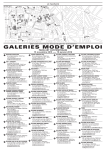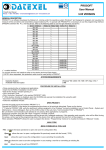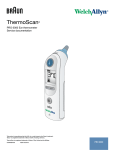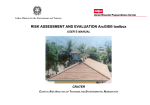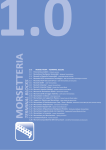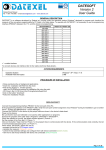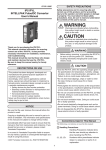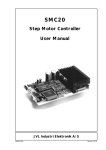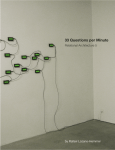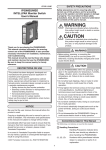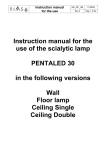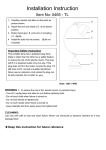Download DAT6021 4 Channel Thermocouple PLC Input
Transcript
DAT 6000 SERIES ANALOG to DIGITAL INTERFACE UNITS for PLC DATA ACQUISITION - USER MANUAL FEATURES - Analog Signal Acquisition on PLC digital I/O - Models and analog inputs : DAT6021 - 4 channels for mV or Thermocouple - 16-bits resolution with high F.S. accuracy - Linearization function for Tc and RTD - PC and DIP-SWITCH configurable - 3-ways 2000Vac galvanic isolation - In compliance with EMC directives - CE mark - 12.5 mm thin profile housing - DIN rail mounting APPLICATIONS - Factory Automation - Building Automation - Agricolture Automation - Chemical Industry Measurement - Security system - Machine Control PRELIMINARY DAT 6000 Introduction The DAT6000 series is an evolution in the connection techniques of the analog signals to the PLC. The devices of this serie performs many functions as: amplification, linearization, isolation, filtering and conversion of analog signals, coming from various sensors, in a high resolution digital signal. The digital signal is transfered to the PLC by a bus connected to any one of the controller’s digital input. It is composed by a series of 16-bit ‘words’ containing the values of the analog signals to be measured. The transfer is PLC controlled by a clock signal coming from one of its output ports. At every clock pulse a bit of the data is transmitted. Using few and simple instructions the PLC is even capable to acquire more analog signal on a single digital input. The devices are also provided of an Enable signal which, handled by the controller, allows to " multiplexing " many devices on the same digital input. The DAT6000 series is composed of the following devices: Device Channels Input Type DAT 6011 2 mV and Tc DAT 6012 2 RTD, Res. and Pot. DAT 6013 2 V and mA DAT 6021 4 mV and Tc DAT 6023 4 V or mA DAT6000 2 PRELIMINARY DAT 6000 How to connect DA T6000 to PLC D AT 60 00 P LC +V 4.7 K N P 4.7 K M O E N A B LE D ATA >560 R C LK GND +V R D C /D C Q + 18..30 V dc The serial interface of the DAT 6000 series devices is shown hereup. Input and output signals are optoisolated among analog input and power supply. The DATA signal circuit is powered directly with the ENABLE signal voltage. Without the ENABLE signal, the data output is disabled. The ENABLE input (terminal N) can be connected directly to the supply voltage, leaving available a PLC output port; in this case the data output is always enabled. Using the ENABLE signal, the CLK signal can be always active, because when ENABLE signal is off, the microprocessor ignores the clock signal, stopping the data sending; by this way, it is possible to connect many devices in multidrop connection, using few PLC I/O ports. The power supply of the DAT6000 is isolated from the serial interface so that the auxiliary supply of the PLC can be used to power it. 3 PRELIMINARY DAT 6000 Multidrop connection The CLK input and the DATA output of the DAT6000 devices are actives only when the ENABLE signal is on. Consequently It is possible to connect all the DATA signals to the same PLC digital input and all the CLK signals to the same PLC digital output. Devices can be activated one by one sending the ENABLE signal to the selected device only. As shown in the figure below, using n°3 DAT6000 devices it is possible to read the value of up to 12 analog sensors using only 4 PLC digital outputs and 1 PLC digital input. Each new device connected will use only one more PLC digital output (ENABLE). Changing the device type, it is possible to create many combinations of analog inputs (i.e.: 4 Tc inputs on the first device, 4 mA inputs on the second device and 2 Potentiometer inputs on the third device), without to change the wiring to the PLC and the software data reading procedure. Tc 1 N Tc 2 Tc 3 P D AT6021 N° 1 M Tc 4 O Tc 5 N Tc 6 Tc 7 D AT6021 N° 2 P P LC D igital I/O M O Tc 8 ENA BLE 1 ENA BLE 2 Tc 9 Tc 10 Tc 11 Tc 12 N D AT6021 N° 3 P M O ENA BLE 3 DATA D igita l o ut D igita l o ut D igita l o ut Digita l in CLK D igita l o ut GN D Ground 4 PRELIMINARY DAT 6000 Analog Inputs connection DAT 6011 mV wiring Tc wiring DAT 6021 mV wiring Tc wiring 5 PRELIMINARY DAT 6000 DAT 6012 2 wires RTD/Res wiring 3 wires RTD/Res wiring Potentiometer wiring 6 PRELIMINARY DAT 6000 DAT 6013 V wiring mA wiring DAT 6023 V wiring mA wiring 7 DAT 6000 PRELIMINARY Technical Characteristics Analog Inputs DAT 6011, DAT 6021 mV Input 50 mV 100 mV 500 mV 1000 mV Min -50 mV -100 mV -500 mV -1000 mV Thermocouple Input Min Tc J -210 °C Tc K -210 °C Tc T -210 °C Tc E -210 °C Tc R -50 °C Tc S -50 °C Tc B +400°C Tc N -210 °C Channels: Max +50 mV +100 mV +500 mV +1000 mV Max +1200 +1372 +400 +1000 +1767 +1767 +1825 +1300 °C °C °C °C °C °C °C °C 2 ( DAT 6011 ) 4 ( DAT 6021 ) Input Type: ± 50 mV to ± 1V Calibration Accuracy: ± 0.1 F.S. Linearity: ± 0.2 % for Tc Lead wire resistance influence: < 0.8 uV/Ohm Input impedance: > 10 MOhm Cold Junction Compensation: ± 0.5 °C Thermal Drift: ± 0.005 % F.S. /°C Sampling Rate: 10 samples/sec Bandwidth: 4 Hz Tc: J, K, T, E, R, S, B, N 8 PRELIMINARY DAT 6000 DAT 6012 RTD Input Pt100 Pt1000 Ni100 Ni1000 Min -200°C -200°C -80°C -60°C Max +850°C +200°C +180°C +150°C Resistance Input Low High Min 0 Ohm 0 Ohm Max 500 Ohm 2000 Ohm Potentiometer Input Min <500 Ohm 0% <2000 Ohm 0 % Max 100 % 100 % Channels: 2 Input Type: RTD (Pt100, Pt1000, Ni100, Ni1000) Resistance and Potentiometer (up to 2KOhm) Calibration Accuracy: ± 0.1°C for RTD; ± 0.1 Ohm for Resistance; RTD Linearity: ± 0.2 °C RTD Excitation Current: 0.350 mA typ. Lead wire resistance influence: < 0.05 %/Ohm (50 Ohm max.) for 3 wires RTD Thermal Drift: ± 0.005 % F.S. /°C for RTD Sampling Rate: 10 samples/sec Bandwidth: 4 Hz ± 0.1 % for Potentiometer; 9 PRELIMINARY DAT 6000 DAT 6013 - DAT 6023 Voltage Input 10 V Min -10 V Max +10 V Current Input 20 mA Min -20 mA Max +20 mA Channels: 2 ( DAT 6013 ) 4 ( DAT 6023 ) Input Type: ± 10V or ± 20 mA * Calibration Accuracy: ± 0.05 % Linearity: ± 0.1 % Input Impedance: > 1MOhm for V ; 47 Ohm for mA Thermal Drift: ± 0.005 % F.S. /°C Sampling Rate: 10 samples./sec Bandwidth: 4 Hz * For DAT 6023 the input type is not configurable. It must be to defined at order (V or mA). DIGITAL INTERFACE Supply Voltage: 24 Vdc typical (30 Vdc max) ON state voltage: > 9 Vdc Input Impedance (ENABLE, CLK): 4.7 KOhm Minimum Output Load (DATA): 560 Ohm Maximum Clock signal frequency: < 500 Hz (with 1ms filter) < 50 Hz (with 10ms filter) Debounce Filter: settable to 1ms or 10 ms Rise Time: <0.2 ms 10 PRELIMINARY DAT 6000 SUPPLY Supply Voltage: Supply Current: Polarity reversal protection: 18 to 30 Vdc 35 mA @ 24 Vdc 60 Vdc Temperature and Humidity Operating Temperature: Storage Temperature: Relative Humidity (not condensing): -10 ÷ +60 °C -40 ÷ +85 °C 0 ÷ 90 % EMC Emission EN50081-2 Immunity EN50082-2 RF Immunity tested @ 10 V/m up to 1000 Mhz Housing Material Mounting Weight Dimensions (W x H x T) in mm: Selfestinguishing Plastic DIN Rail 50 g. approx. 90 X 98 X 12.5 Mechanical Dimensions (mm) I L SW 1 G H 98 SW 4 E F 12.5 90 11 PRELIMINARY DAT 6000 How to Program the module The input type is in-field configurable by means of the dip-switches. The input type configuration is made by SW1..SW3 dip-switches which can be used to set up to 8 different input types. The standard correspondance between the dipswitch setting and the relative input type is shown in the tables below. It can be modified using the ‘PRO6000’ software and the PRODAT-03 interface. By this way, it is possible to reconfigure the module for a wide range of input signal types at any time. Also the CLK signal’s digital filter can be set to 1 ms or 10 ms (half-period duration) by a dip-switch (SW4). The digital filter eliminates all the signal variations shorter than the specified time, avoiding undesired command simulations. Hereafter the standard tables of the various modules are shown: DAT6012 and DAT6013 modules, having a limited number of possible input types, are availables with a fixed table. Whereas DAT6011 and DAT6021 are available as in Tab.A or in Tab.B, indicating the choice at the order, or in any desired configuration using the software, as previously mentioned. DAT6023 module is not configurable; consequently the input type (V or mA) must be defined at the order phase. DAT6012 DAT6011 - DAT 6021 SW1 SW2 SW3 0 0 0 0 1 1 1 1 0 0 1 1 0 0 1 1 0 1 0 1 0 1 0 1 Input Tab.A Tc J Tc K Tc T Tc E Tc R Tc S Tc B Tc N Input Tab.B 50 mV 100 mV 500 mV 1000 mV --------- SW1 0 0 0 0 1 1 1 1 SW2 SW3 Input 0 0 Res. L 0 1 Res. H 1 0 Pt100 1 1 Ni100 0 0 Pt1000 0 1 Ni1000 1 0 Pot. L 1 1 Pot. H DAT6013 SW1 x x SW2 SW3 Input x 0 10 V x 1 20 mA 12 PRELIMINARY DAT 6000 How to create an Input Table All the possible input types of the module are listed in a main table (Tab.1). It is possible to associate up to 8 of this input types to each one of the 8 dip-switch combinations, following the order of Tab.1 and compling to every choosed type the first free dip-switch combination. By this way the ‘dip-switch to input type’ correspondence table is created (Tab.2). The example is referred to DAT6011 module and shows how to associate the height dip-switch combinations to three ‘mV’ inputs (50mV / 100mV / 1000mV) and five ‘Tc’ inputs (Tc J/K/R/S/N): Tab.1 Pos. 0 1 2 3 4 5 6 7 8 9 10 11 12 13 14 15 Input 50 mV Tc J Tc K Tc T Tc E Tc R Tc S Tc B Tc N ----100 mV 500 mV 1000 mV 50 mV Tc J Tc K Tc R Tc S Tc N Tab.2 SW1 SW2 0 0 0 0 0 1 0 1 1 0 1 0 1 1 1 1 SW3 0 1 0 1 0 1 0 1 Input 50 mV Tc J Tc K Tc R Tc S Tc N 100 mV 1000 mV 100 mV 1000 mV In any case, it is sufficient to set the desired data in the “PRO6000” program, and the table will be automatically created. Moreover the software will provide to program the module in the correct way. 13 PRELIMINARY DAT 6000 Data Reading The data transfer is made sending an enabling signal (ENABLE) and a clock signal (CLK). If the ENABLE signal is high, a bit composing the reading is provided on the output (DATA) at every clock pulse. Every reading cycle is composed of 1 synchronism bit followed of a 16 bit word for each analog input signal (channel). So that any reading is composed of 33 bits for 2-channels and 65 bits for 4-channels. The synchronism bit indicates that the next bit is the most significant bit of the first channel value (A15); the following remaining bits of this value will be transmitted down to the least significant bit (A0). This bit will be followed by the most significant bit of the second channel value (B15), down to the least significant bit (B0). After the last bit, a new synchronism bit will be transmitted. The value to be transmitted will be updated during the transmission of the synchronism bit. During the reading cycle, the ENABLE signal must stay at logic level HI. The first bit after the ENABLE signal rise front will be a synchronism bit. The synchronism bit level is high when the CLK signal is high and is low when the CLK signal is low. Differently, each data bit is updated on the CLK rise front and mantains its level until the next CLK rise front. At any moment it is possible to send a rise front on the ENABLE signal to restart the reading cycle (by the synchronism bit). The ‘Debounce Filter’ eliminates all the signal variations shorter than the specified time, avoiding undesired command simulations. 14 PRELIMINARY DAT 6000 How to write the PLC’s instructions The correct procedure to acquire the measures by the module can be described as following: Start condition: ENABLE low and CLK low, then DATA is automatically low. Initialization: 1 - ENABLE High 2 - Wait for Tr Synchronism: 3 - CLK High 4 - Wait for Tr 5 - Read DATA 6 - DATA logic level must be 1 otherwise go to point 3 * 7 - CLK Low 8 - Wait for Tr 9 - Read DATA 10 - DATA logic level must be 0 otherwise go to point 3 * Bit reading: 11 - CLK High 12 - Wait for Tr 13 - Read DATA 14 - CLK Low 15 - Wait for Tr 16 - Read DATA 17 - DATA logic level read on point 13 and on point 16 must be the same, otherwise go to point 3 * 18 - Save the DATA logic level as bit in the reading register Channel reading: 19 - Repeat points 11 to 18 for all the 16 bits of the measure, writing the bits in the reading register from the most significant one down to the least significant one 20 - Repeat points 11 to 19 for all the channels to read 21 - After the 16° bit of the last channel (2nd or 4th) return to point 3 To abort the reading without to read all the channels: 22 - Be sure the CLK is Low 23 - ENABLE Low 24 - Wait for Tr 25 - Go to point 1 * Synchronization is failed, then disregard the last reading. The data acquisition will be delayed until the next synchronism bit will be recognized. It is advisable to abort the reading procedure going to point 22. NOTE: ‘Tr’ is the Debounce Filter time setting (1ms or 10 ms) 15 DAT 6000 PRELIMINARY The following two examples, each one toghether with its flow-graph, illustrate the procedure to be followed for writing the PLC’s instructions. EXAMPLE n°1 : 2 or 4 channels reading Definitions: ENABLE, CLK and DATA = interface signals SYNC = synchronism bit REGISTER = data reading buffer n = a bit of REGISTER buffer (0..15) CHANNEL = digital channel measurement value a = channel number (1,2,3 or 4) x, y = bits START DELAY ENABLE HIGH DELAY ENABLE LOW A DELAY = delay function (ms). The delay time must be higher than the setting of the digital filter NOTE 2 a=0 READ BIT The first bit is the most significant n = 15 READ BIT CLK HIGH READ BIT DELAY REGISTER [n] = y read input bit CLK LOW n=n-1 DELAY NO read next bit n=0? YES y = DATA end of channel reading a=a+1 CHANNAEL (a) = REGISTER NO read next channel a=2? (NOTE 1) YES end of channels reading NOTE 1 : to be modified following the number of channels to be read ( write " a = 4 ? " for the 4 channels reading ) NOTE 2 : follow the (A) option to reset the device or for not reading the unused channels The procedure is fast and with few instructions because there are not synchronism controls. However, if the synchronism is lost (i.e. for a noise), the reading will be wrong. To avoid that, it is advisable to use the ENABLE signal to synchronize the procedure at the reading start. 16 PRELIMINARY DAT 6000 EXAMPLE n°2 : 2 or 4 channels with synchronism control START Definitions: ENABLE, CLK and DATA = interface signals SYNC = synchronism bit REGISTER = data reading buffer n = a bit of REGISTER buffer (0..15) CHANNEL = digital channel measurement value a = channel number (1,2,3 or 4) x, y = bits DELAY ENABLE HIGH ENABLE LOW DELAY A NOTE 2 first channel reading a=0 DELAY = delay function (ms). The delay time must be higher than the setting of the digital filter READ BIT SYNC ? NO YES synchronism found READ BIT the first bit is the most significant n = 15 CLK HIGH READ BIT DELAY x = DATA DATA ? CLK LOW NO wrong bit received YES data-bit received DELAY REGISTER [n] = y y = DATA x=1 y=0 x&y compare read input bit x=0 y=1 n=n-1 NO read next bit n=0? YES end of channel reading a=a+1 x=y SYNC DATA ERROR CHANNEL (a) = REGISTER NO read next channel a=2? (NOTE 1) YES end of channels reading NOTE 1 : to be modified following the number of channels to be read ( write " a = 4 ? " for the 4 channels reading ) NOTE 2 : follow the (A) option to reset the device or for not reading the unused channels The continuous control of the received bit allow a sure synchronization of the procedure. When the synchronism is lost, the next reading will be surely correct because it will starts only when a synchronism bit will be recognized. It is not necessary to use the ENABLE signal. 17 PRELIMINARY DAT 6000 Data Format The module acquires the analog signal value of each channel and converts it in a digital string (bit). Each analog signal is converted in a 16 bit word which is serially transmitted as before described. Then, it is possible to convert the received string in the corresponding decimal value, considering that each value is expressed in signed integer (the most significant bit indicates the sign: 0=positive 1=negative). The user will must insert the decimal point as illustrated in the following tables. Input Decimals +/- 50 mV +/- 100 mV +/- 250 mV +/- 1000 mV +/- 20 mA Tc J .. Tc N 3 2 2 1 3 1 Format Input +50.000 +100.00 +250.00 +1000.0 +20.000 +1200.0 RTD (°C) Res (Ohm) Pot (%) Decimals Format 1 1 1 +850.0 +2000.0 +100.0 Hex Decimal Measure 0001 2134 FFFF F830 1 8500 -1 -2000 0.1 Ohm 85.00 mV -0.1 mV -200.0 °C Examples: Input Binary Ohm 100 mV 1000 mV Tc J 0000 0010 1111 1111 0000 0001 1111 1000 0000 0011 1111 0011 0001 0100 1111 0000 18 PRELIMINARY DAT 6000 NOTE : 19 DAT6021 4 Channel Thermocouple PLC Input Phone: +1 225 200 7419 E-mail : [email protected] - Web Site www.datexel.com




















